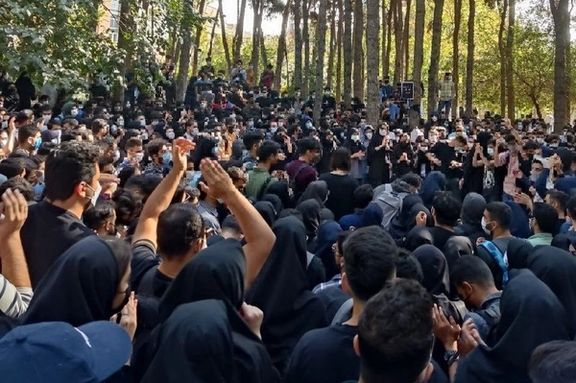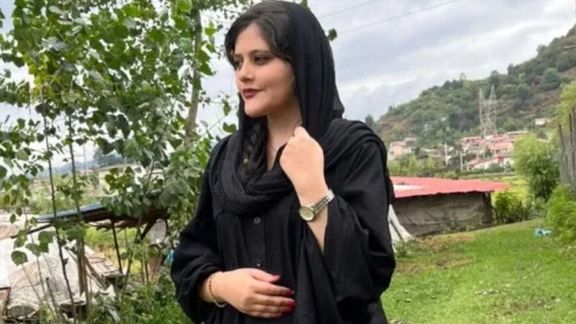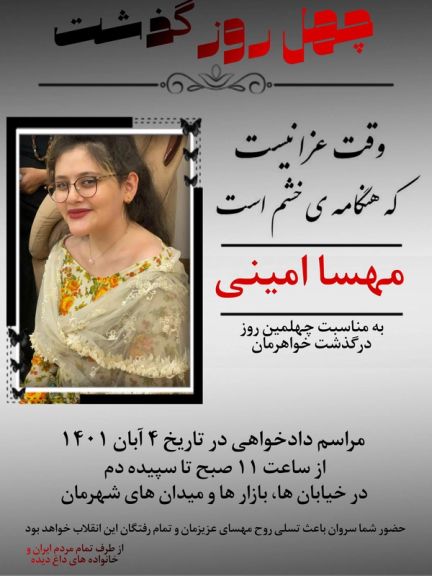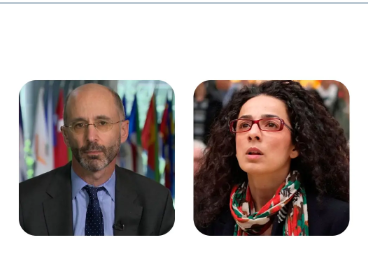US Envoy To UN Meets Special Rapporteur On Iran’s Human Rights

The United States is apparently pushing the United Nations to hold the Islamic Republic accountable for its violent crackdown on antigovernment protests.

The United States is apparently pushing the United Nations to hold the Islamic Republic accountable for its violent crackdown on antigovernment protests.

Defiance of a rule that requires male and female students eat separately in canteens spreads in Iranian universities as civil disobedience to gender apartheid.
On October 4, a few brave female students of the literature and languages faculty of Allameh Tabatabi University in Tehran removed their headscarves, marched into the boys’ canteen, and sat to eat after protesting and chanting outside for hours and more female students joined in.
The move was welcomed by everyone, who chanted “Women, Life, Freedom” and clapped as a short video posted on Twitter showed. Students have been eating together there since the taboo was broken, despite threats of disciplinary action and even expulsion.
Students in many other universities have followed suit as canteens were “reclaimed” as students say. But in some universities, there have been stand offs with authorities and hardliner students who often belong to the student wing of the Revolutionary Guards’ Basij militia.
Wherever students are being barred from dining together, they stage protests outside the buildings and chanting slogans, waving their headscarves above their heads.
In some universities students are taking their food trays outside to eat together in the open or arranging the trays in a row on the ground and refusing to eat the food while chanting and protesting.
For four decades authorities have imposed gender-segregation in universities. Male and female students are required by an unwritten law to sit in two separate parts of classrooms and lecture halls, eat in separate canteens or in the same canteen but at different hours, exercise and compete in separate sports facilities, and live at separate dormitory buildings unless they reside in dormitories allocated to married students.
In the religious city of Qom which is also home to many seminaries, students’ insistence on breaking the segregation taboo ended in a standoff with school security on Tuesday, who closed the canteen door to stop boys and girls from entering together.
After some chanting, students tried to force their way in but security used violence against the students who did not give up and finally went in to buy their food. They took their trays out and had a huge picnic outside, defying segregation.
On Monday at Sharif Industrial University in Tehran cafeteria chairs, tables, and windows were broken during a standoff between protesters and Basij members. Protesting students said on social media later that they had tidied the place up after the standoff and set up a fund for replacing damaged furniture.
Meanwhile, the Basij students took to the memorial of unknown soldiers buried inside the university and mourned what they considered as sacrilege against those martyred for Islam and Islamic laws.
Photos posted on Twitter show several Basij students laying their heads on the tomb of an unknown soldier and crying. The remains of three unknown soldiers of the Iran-Iraq War (1980-1988) were buried on the campus in 2006 despite the opposition of over 80 percent of students who voted against it in a poll. Those opposed argued that insistence by hardliners to bury the unknown soldiers inside the campus was a symbol of their political dominance.
Videos posted on social media Tuesday showed TV football commentator and producer Adel Ferdosipour, who also teaches English at Sharif Industrial University, joining students’ sit-in/picnic outside the canteen in a display of support and solidarity, which students hugely welcomed. Ferdosipour who enjoys popularity among Iranians for his honesty and open criticism of the hardliner establishment was included in Newsweek’s list of the 20 most powerful Iranians in 2009.

Unknown gunmen shot dead two officers of Iran’s Revolutionary Guard (IRGC) in Zahedan, the provincial capital of the largely Sunni Muslim southeastern province of Sistan and Baluchestan.
An IRGC Colonel, identified as Mehdi Mollashahi, and Javad Keikha a member of the Salman Brigade, which belongs to IRGC's Basij paramilitary forces, were killed Tuesday when gunmen opened fire at them from a car and fled, the IRGC-affiliated Tasnim news reported.
The incident followed weeks of brutal crackdown by the IRGC and other Iranian security forces on protesters in Zahedan, who have joined the nationwide antigovernment protests triggered by the death in custody of 22-year-old woman Mahsa Amini.
Earlier in the week, the influential leader of Iranian Sunnis among the Baluch held Supreme Leader Ali Khamenei responsible for the September 30 massacre of Sunnis in Zahedan.
The intelligence chief of the IRGC in the province was also shot dead earlier in the provincial capital Zahedan. According to Tasnim, in addition to Colonel Mousavi, three other members of IRGC and its Basij paramilitary force were killed and 32 more injured in Zahedan clashes.
The attack by the IRGC on protesters, September 30, left more than 90 unarmed Baluch citizens dead as reported by human rights watchdogs in Iran and abroad. Sunnis in Iran comprising at least 10 percent of the population have had a rocky relationship with the Shiite clerical regime for four decades.

Anti-government protests in Iran continued Tuesday with university students at the forefront of expressing anger at gender segregation and government brutality.
Students at a university in Qom, which is the Shiite religious center in Iran disrupted a speech by the government spokesman, who had been booed and silenced on Monday at another university in Tehran. They chanted “Student Dies but does not accept humiliation!” and did not let Ali Bahadori Jahromi to speak.
Qom University students also chanted slogans against Iran’s state broadcaster when its notorious correspondent Yusef Salami was trying to report from the venue of the government spokesman's speech.
In the capital students of Tehran, Beheshti, Modarres, Khajeh Nasir, Sureh, Alzahra, Azad and Allameh universities chanted different anti-regime slogans including “Tehran has turned into detention center, Evin [prison] has turned into slaughterhouse” and “Death to Dictator!”
Students in Tehran's Allameh University chanted Tuesday as they gathered around a symbol of nearly 30 children killed in the past few weeks of the uprising against the Islamic Republic.
Videos show a group of students gathered for a protest near Emam Hussein Square in central Tehran, joined by other citizens who were chanting slogans.
Iranian students in Yazd, Shar-e Kord, Babol, Karaj, and several other cities also chanted radical slogans like “Death to this Leadership”, referring to Iran’s ruler Ali Khamenei, and “Don't call me seditionist! You oppressors are the seditionists.”
The civil disobedience movement of men and women eating together at canteens in defiance of the gender segregation rules also gained momentum on Tuesday. Most universities closed their cafeterias to prevent mixed-gender dining and students had lunch sitting on the ground outside.
Meanwhile, several women’s rights activists called on the people to gather at the main squares of different cities on Wednesday to commemorate the 40th day after the death of Mahsa Amini. Shia Muslims hold a commemoration ceremony on the seventh and fortieth day after the death of a person.
This has a big cultural significance in Iran and protests are expected to be large on Wednesday.
Earlier, the anonymous activist group calling itself ‘Youths of Tehran's Neighborhoods’ published a notice urging all Iranians to gather in their cities and towns around universities and markets around noon. The group has been the main engine driving nationwide protests each Saturday and Wednesday during October.
However, government’s official news agency IRNA claimed that the family of Mahsa Amini has announced they are not going to hold the 40th day ceremony, to prevent “any unfortunate incidents”, but people on social media say this is a disinformation to stop protests.
In the meantime, industrial and business strikes spread further on Tuesday. Iranian human rights activist Atena Daemi said in a tweet that “The Free Union of Iranian Workers has announced that the employees of Tabriz Tractor Factory have stopped working and joined the nationwide strikes.”
Another user has said that restaurants and cafeterias in the northern city of Rasht have gone on strike and will be closed on Wednesday as a sign of respect on the 40th day ceremony of Mahsa Amini.
A journalist also announced that the workers of Phase 2 of Abadan Refinery will start a new round of strike on Wednesday.
The workers of Bandar Abbas, Mahshahr, Assaluyeh, and Kangan refineries in the south are reportedly on strike as well.
Workers at South Pars Gas Complex, Fars Ghadir Neyriz Steel Company, Haft Tappeh Sugar Cane Factory, Mahshahr Tube Factory, Bushehr Petrochemical Complex, Kian Tire Factory, Borujerd Textile Factory, Isfahan’s SNOWA company, Khuzestan National Steel Group, Aidin Chocolate Factory in Tabriz, as well as truck drivers continue their strikes.

Calls for rallies and strikes are pouring in for Wednesday, October 26, the 40th day since the death in custody of a young woman that sparked the protests, a culturally important tradition.
People from various groups and strata of the Iranian society have announced calls for gatherings in numerous cities to mark the 40th day of Mahsa Amini’s death, which carries immense significance in the Iranian culture.
Young grassroot activists in Tehran -- calling themselves Youths of Tehran’s Neighborhood (Javanan-e Tehran) -- that have mobilized thousands of protesters in several towns and cities since the current wave of protests began, published a notice on Tuesday urging all Iranians to gather in the their neighborhoods, around the universities and markets around noon.

Young grassroot activists in Tehran -- calling themselves Youths of Tehran’s Neighborhood (Javanan-e Tehran) -- that have mobilized thousands of protesters in several towns and cities since the current wave of protests began, published a notice on Tuesday urging all Iranians to gather in the their neighborhoods, around the universities and markets around noon.
"We back every measure against the tyrannical and corrupt Islamic regime, and we keep the fire of this revolution burning” in order to garner more support through participation of people inside and outside of Iran, they said.
Holding rallies on the 40th day of people died during the Islamic Republic’s crackdown on protesters is reminiscent of a similar turn of events 44 years ago, during the revolution against monarchy that culminated in the overthrow of the Pahlavi dynasty under Shah Mohammad Reza Pahlavi, and the establishment of the Islamic Republic in 1979. Marking the 40th day for people who were killed during the revolution turned into fresh protests that fueled the movement.

Iranian activist Masih Alinejad has launched a campaign to gather signatures from people who believe it is time to remove US Special Envoy for Iran Robert Malley.
The online campaign, which has so far been signed by over 115,000 people on worldwide nonprofit petition website change.org since it was started on Monday, is organized as a protest to a tweet by the envoy on Sunday that said Iranian protesters want respect from the Islamic Republic. The campaign also aims to remove Malley’s deputy Jarrett Blanc.
The campaigners say while Iranians are seeking a regime change, Joe Biden’s representatives refuse to recognize their demands and their policies are fixated on a nuclear deal with the Islamic Republic.
“Iranians of all ages and social groups are protesting to replace the Islamic Republic, a religious dictatorship, with a democratic and secular form of government. Yet, President Biden’s Iran Envoy, Robert Malley, is misrepresenting the nature of the protests, pushing for negotiations with the Islamic Republic,” the campaign stated.
Malley minimized the Iran protest movement by portraying it as merely a quest by Iranians to have the government in Tehran “respect their human rights and dignity”, ignoring their call for change, Alinejad said.
Redeeming his remarks, Malley told Iran International on Monday that that his Sunday tweet on Iran protests, which led to negative reactions, “was poorly worded.”
“It is not up to me; it is not up to the US government what the brave women and men who have been demonstrating in Iran want. It is up to them,” Malley said.
During a meeting on Wednesday the US Ambassador to UN Linda Thomas-Greenfield and Javaid Rehman, the UN Special Rapporteur on the Human Rights Situation in Iran reiterated calls for an independent investigation to hold those responsible for the violence being carried out by the government of Iran accountable.
Appreciating the Special Rapporteur’s reporting on the human rights situation, the US ambassador especially thanked Rehman for his work to highlight Iran’s continuing repression of peaceful protesters and the rights of women and girls.
Ambassador Thomas-Greenfield repeated Washington’s stance that it will “continue to stand with the brave Iranian people as they call for equal rights and basic human dignity.”
Earlier this month, White House National Security Advisor Jake Sullivan said that the entire world is watching the current situation in Iran, reiterating that the United States stands with the Iranians.
Washington on October 6 imposed sanctions on seven Iranian officials over the shutdown of internet access and the crackdown on peaceful protesters. The EU is also putting significant pressure on Iran to stop Tehran from mistreatment of citizens.
Since the protests started over the death in custody of 22-year-old Mahsa Amini, several human rights bodies and NGOs have called on the international community to "support calls for the establishment of an independent to address the prevailing crisis of impunity in Iran."